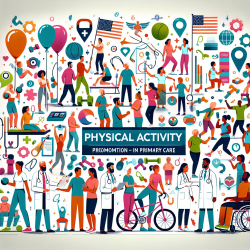Introduction
Physical inactivity is a significant risk factor for non-communicable diseases (NCDs), contributing to millions of deaths worldwide annually. Despite the well-documented benefits of physical activity (PA) in reducing the incidence of NCDs and improving mental well-being, its promotion in primary care remains inconsistent. The research article "Physical activity promotion in primary care: a Utopian quest?" highlights the potential of brief interventions and exercise referral schemes in primary care settings. These strategies, if effectively implemented, can significantly enhance patient health outcomes.
Implementing Evidence-Based Strategies
The research underscores two primary approaches to PA promotion in primary care: brief interventions and exercise referral schemes. Both have shown promise in increasing PA levels among patients at risk of NCDs.
- Brief Interventions: These involve short discussions or negotiations, often lasting only a few minutes, to encourage patients to engage in PA. Studies indicate that brief interventions can lead to increased PA levels, although long-term impacts require further exploration.
- Exercise Referral Schemes: These involve formal referrals to PA professionals, providing structured support for patients. Such schemes have demonstrated small but positive effects on increasing moderate-intensity PA among participants.
Enhancing Practitioner Skills
For practitioners looking to improve their skills in promoting PA, the research highlights several key enablers:
- Training and Support: Adequate training in PA counseling is crucial for healthcare professionals. This includes understanding how to assess patients' PA levels and provide tailored advice.
- Motivational Interviewing: Utilizing motivational interviewing techniques can enhance patient engagement and adherence to PA recommendations.
- Multidisciplinary Approaches: Collaborating with other healthcare professionals and community resources can create a supportive environment for patients to increase their PA levels.
Encouraging Further Research
While the current evidence supports the effectiveness of brief interventions and exercise referral schemes, gaps remain in understanding their long-term impact and cost-effectiveness. Practitioners are encouraged to engage in further research to explore these areas and develop more comprehensive strategies for PA promotion in primary care.
Conclusion
Promoting physical activity in primary care is not a utopian quest but a feasible goal with significant health benefits. By implementing evidence-based strategies and continuing to explore innovative approaches, healthcare professionals can play a pivotal role in reducing the burden of NCDs and improving patient outcomes.
To read the original research paper, please follow this link: Physical activity promotion in primary care: a Utopian quest?










